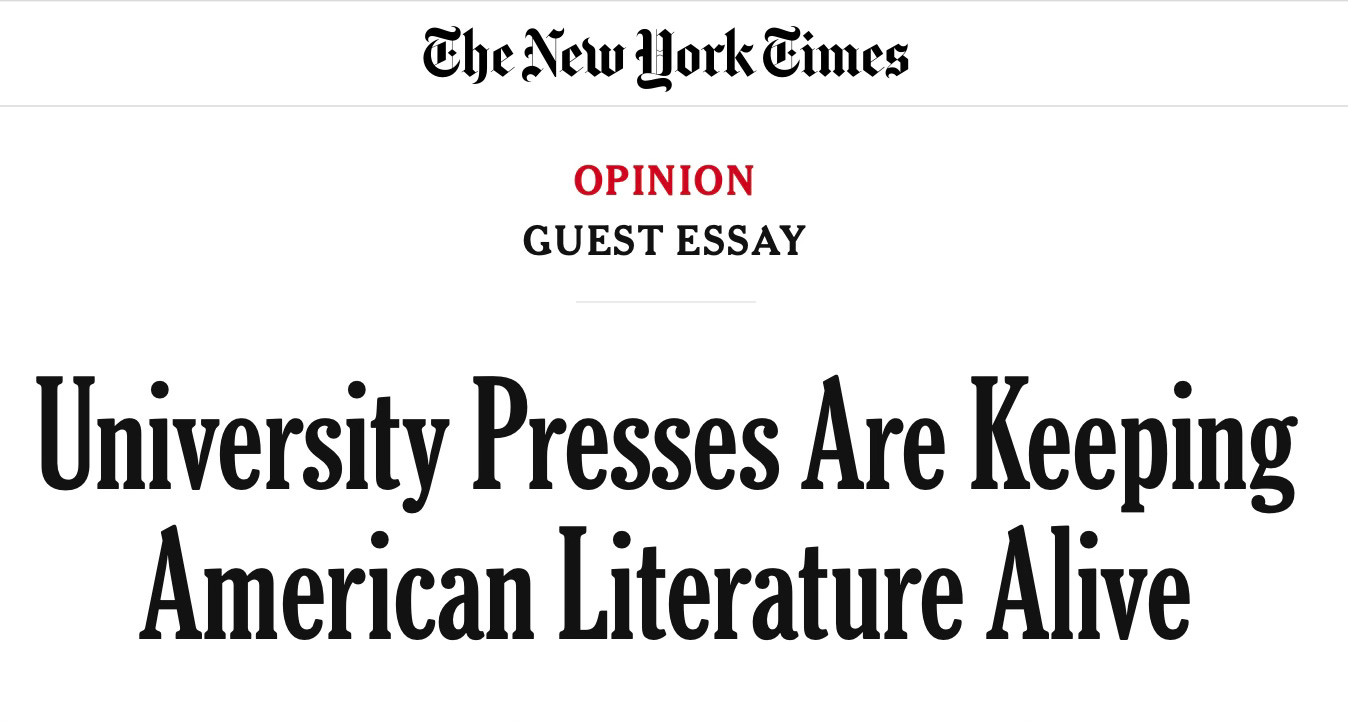I’m posting here a slightly different version of my February essay from the Chronicle of Higher Education, just in the interest of helping the piece continue to circulate in forms that are easily shared. Big thanks to the Chronicle for their support!
As part of my freelance work with Kent State University Press, I’m spending some of this season drumming up awareness of (among other titles) Ghosts of an Old Forest by Deborah Fleming, a retired professor of English at Ashland University. It’s a task made considerably easier by the success of Fleming’s previous book, also with Kent State. Resurrection of the Wild was published in 2020 and won the PEN/Diamonstein-Spielvogel Award for the Art of the Essay, judged that year by Jelani Cobb, Daniel Menaker, and Judith Thurman.
Those are marquee names, and my Kent State colleagues got to celebrate at a ceremony emceed by Seth Meyers—not the kind of thing most readers immediately associate with university-press publishing. But Fleming and Kent State are not alone, even among their cohort of presses in Ohio. Just this fall the tiny University of Akron Press had the winner of the National Book Award for poetry with Lena Khalaf Tuffaha’s Something About Living. (Their ceremony was overseen by Kate McKinnon.) Ohio State University Press had a National Book Award finalist in the highly competitive nonfiction category in 2020 with How to Make a Slave and Other Essays by Jerald Walter at Emerson College. Just in-state, the list of nationally recognized books from university presses is impressive. Expand out and you get much more—a personal favorite is Percival Everett’s Erasure, which became the Oscar-nominated movie American Fiction. It was originally published by the University Press of New England. Imagine the world without these books.
I’d go as far as to argue that we’re in a golden age for university-press publishing. Driven by mission and tolerant of risk, these houses are publishing some of the most vital books around. And not just vital in the sense of “fifty specialists will read them and they’ll shape influential-but-poorly-understood research” (although that’s important too). University presses—including small ones—are publishing big books.
I’m not alone in this assessment. In 2022, Margaret Renkl wrote an essay in the New York Times with the headline “University Presses Are Keeping American Literature Alive,” using as evidence titles from the presses at Vanderbilt, Ohio, Georgia, and West Virginia (which I then directed). It’s an incredible endorsement of university presses’ work from the country’s most influential perch. I’m going to go out on a limb and guess you may never have heard about it.
If those successes don’t dominate public conversations about university presses, I think one reason is a technophilic tendency to elevate how books get published over what gets published. Experiments designed to transform academic and university-based publishing sometimes seem to crowd out news of actual, individual books. It’s part of a Silicon Valley–friendly worldview characterized by enthusiasm for a number of innovations, most recently Artificial Intelligence.
I sense at least a little gloom in the current fixation on disruption. Authors are angry about reports that some houses (including some of the biggest university presses) are licensing their books to train AI. There have been significant layoffs at one AI-curious press—leaving me to wonder (as one has to, these days) whether human work is vulnerable to being replaced. And authorship itself may not be immune, as UCLA brags of developing course materials generated by AI.
I don’t mean to paint with too broad a brush, and there may certainly be worthwhile new developments to emerge at the disruptive end of publishing. But the tradition of craft in university-press publishing is at least as important—and worthy of wider celebration, I think, than it receives, particularly as enthusiasm for machine learning consumes ever more oxygen. It’s a tradition that’s not just laudable, but successful.
Some context: In the United States, most university presses have a program that includes trade books aimed not primarily at libraries, course adoption, or reference shelves, but at general-interest readers. These can be essays or fiction or poetry but also range from regional titles to perspectives on current events to books about food. Just last year, to pick a prominent example from outside the narrowly literary world, the University of Nebraska Press had a finalist for the Pulitzer Prize with a work of history.
There’s sometimes a tendency to see trade books as a distraction or, at best, a necessary concession—a way to help offset the costs of university presses’ true mission of publishing monographs. I think that view is misguided, in part because many authors of general-interest books are based at universities, but also because the trade books from university presses often wouldn’t be published (or published the same way) by commercial houses. In an interview, Percival Everett expressed pleasure about publishing Erasure with the University Press of New England, adding: “All the other houses ran away from it.” There’s a slogan. University presses: The publishers who don’t run away.
Many of those fearless presses are responding to significant challenges even as they publish nationally recognized work. Akron was slated for closure in 2015 before being spared the chopping block and then having two titles recognized as part of the National Book Awards—Lena Khalaf Tuffaha’s winner this year and Leslie Harrison’s The Book of Endings, which was shortlisted in 2017. Everett’s original publisher, the University Press of New England, was actually shut down in 2018 before Brandeis University Press, a member of the New England consortium, resurrected it in 2021. Happy outcomes in both cases, but reasons to balance celebration with vigilance.
To my mind these challenges amount to something far short of the crisis that some observers identify, and they might be preempted or contained if more conviction were brought to celebrations of university-press success. When a book from a university press is feted by celebrities or becomes a New York Times bestseller, is it an outlier? Sure, but outliers in other areas of the university—a Rhodes scholar, a Nobel-winning physicist, a bowl-bound football team—are justly held up to reflect positively on the larger endeavor, building enthusiasm for more modest but very real accomplishments among the rest of the university community. Bringing a similar approach to the treatment of publishing could mean centering university-press success so that presses are seen not as something to fix but as something to invest in.
The upside to centering breakout successes would, I believe, be felt widely. When I asked one director about his press’s remarkable experiences with national prizes, he told me: “University presses publish from a high ground of care and book-making expertise.” Those qualities are worthy of special attention when a title wins a big award, but they’re applied to books across the program, with a broad benefit to authors and readers. Putting success at the center of conversations about university presses means putting craft at the center of those conversations, and serves as a reminder that at their best, university presses aren’t publishing information or research or content but books—crafted with care by skilled professionals who are animated by the values of the university community.
And those values should include holding up the importance of books, even in a time of rapid technological change. Like a lot of readers, I was shaken by Rose Horowitch’s recent Atlantic essay alleging that college students are no longer capable of reading whole books. If universities are committed to sending the message that reading books is actually a priority, then investing in the people who make real books, at the highest level, becomes that much more valuable. The way higher ed talks about its university presses is the way it talks about books, and I see only upside to nurturing responses like excitement and pride.
Finally, it isn’t a coincidence, I think, that prominent successes are often from university presses that are some combination of smaller, attached to public universities, and geographically distant from the big media networks in New York. To me that’s exciting because it presents an opportunity to draw attention to university-press virtues like groundedness, independence, and connection to community. University presses achieve success not despite higher education’s diversity but because of it. Championing recognition for a book from the University of Akron alongside one from Yale demonstrates the need for presses at both sorts of universities. It’s an invitation to celebrate the best that higher education can do.





I appreciate this long-overdue article about the dedicated excellence of some university presses, including and especially those who promote international literature and "minority literature."
Syracuse University, for many years,has published classics of Middle Eastern literature, with such masterful,dynamic poetry books as Mahmoud Darwish's Adam of Two Edens and Samir Al Qasims'. Texas University Press and Arkansas U Press have also published works by ED, Alicia Ostriker,Toi Derricote,Cornelius Eady, and other. Shout out to U of GeorgiaPress for keepng in print two two scintillating classics ofAmecan (U( novels- John Killens' And Then We Heard The Thunder, and Tom Kromer' unforgettable short novel Waiting For Nothing, a terse epic and the homeless of the 1930s.
Thank you for your talk today in our class!